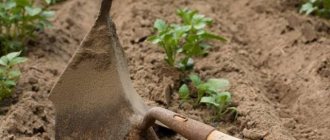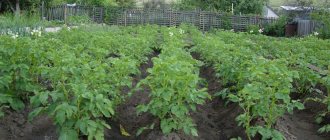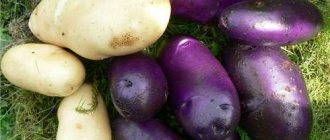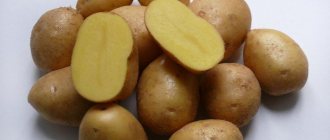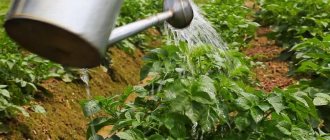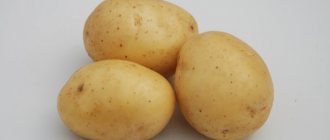The history of the origin of the Ramona potato variety
The origin of Ramona potatoes is seed (Netherlands).
The year of registration in the State Register of Russia is 1994.
The table below presents data on the yield of other potato varieties:
| Name | Variety | Productivity |
| Nikulinsky | Late ripening | From 170 to 300 centners per hectare. |
| Cardinal | Late ripening | From 200 to 350 centners of potatoes are harvested from 1 hectare. |
| Rocco | Late ripening | From 350 to 400 centners per hectare. |
| Kiwi | Late ripening | From 1 kg of planting tubers it reaches 20 kg. |
| Picasso | Late ripening | From 1 hectare about 20 tons. |
| Borovichok | Early ripening | 200-250 centners per 1 hectare of land. |
| Elmundo | Early ripening | 250-350 centners per hectare. |
| Felox | Early ripening | 250 centners per hectare. |
| Bellarosa | Early ripening | The harvest from one bush is 8-10 tubers. |
| Natasha | Early ripening | From 130 to 190 centners per hectare. |
| Forty days | Extra early | Up to 300 centners of potatoes are harvested from one hectare of soil. |
| Karatop | Extra early | From 18.5 to 27 tons per hectare (Middle Volga region), from 20 to 43.5 tons per hectare (Northwestern region). The maximum yield is 50 tons per hectare. |
| Riviera | Extra early | After the first digging on the 45th day after the emergence of potato shoots, it ranges from 134 to 225 centners per hectare. The maximum yield by the end of the growing season reaches 450 centners per hectare. |
| Zhukovsky early | Extra early | The harvest from one bush is up to 15 tubers. |
| Minerva | Extra early | Fertile soils allow you to harvest the first harvest of up to 230 centners per hectare. By the end of the growing season (45-50 days), the maximum yield is achieved - up to 430 centners per hectare. |
| Crane | Mid-late | 640 centners per hectare. |
| Sorcerer | Mid-late | Productivity varies from 27 to 35 tons per hectare. |
| Mozart | Mid-late | The average yield is approximately 430 c/ha. |
| Grenada | Mid-late | From one hectare you can harvest up to 60 tons of potatoes. |
| Ramona | Mid-late | The yield is consistently average from 10 to 15 tons per hectare. |
| Yanka | Mid-early | The average yield ranges from 195 to 315 centners per hectare. |
| Giant | Mid-early | The average harvest ranges from 290 to 424 centners per hectare. |
| Tuscany | Mid-early | Productivity varies from 210 to 400 centners per hectare. |
| Purple Haze | Mid-early | Productivity varies from 182 to 309 centners per hectare. |
| Santana | Mid-early | The average yield varies from 164 to 384 centners per hectare. |
Recommended regions for cultivation:
- Central;
- Volgo-Vyatsky;
- Far Eastern;
- Southern;
- Perm region.
The Dutch have developed the potato of the future:
Description of the variety
Roots:
- The tubers are light pink in color, with a dense, strong skin;
- They have a regular round-oval shape;
- Small eyes, medium deep;
- The pulp is creamy when cut, dense;
- Starch content varies from 14 to 17%;
- Average weight 70-90 grams;
- The harvest from one bush is from 16 to 20 tubers.
Bushes:
- The plant is erect, spreading and tall;
- Quickly forming bushes with high foliage;
- The flowers are red or light purple;
- The corolla is reddish-violet, medium-sized.
Reviews from potato growers
Romantse potatoes have good taste and a predominantly firm texture after cooking. The tubers are characterized by poor digestibility and slight darkening as a result of cooking, but do not darken during the process of cleaning and slicing.
Summer residents note very uniform seedlings and the fastest growth of potato tops. The Romantse potato is characterized by gardeners as a variety with very beautiful red tubers with excellent taste and high stability of quality indicators.
Advantages and disadvantages
Potatoes of the Ramona variety have the following advantages:
- Excellent presentation, leveled tomatoes;
- Undemanding to the type of soil;
- Excellent drought tolerance;
- Capable of producing double harvest per season.
We invite you to familiarize yourself with potato varieties that have different ripening periods:
| Late ripening | Early ripening | Very early | Mid-late | Mid-early |
| Nikulinsky | Borovichok | Forty days | Crane | Yanka |
| Cardinal | Elmundo | Karatop | Sorcerer | Giant |
| Rocco | Felox | Riviera | Mozart | Tuscany |
| Kiwi | Bellarosa | Zhukovsky early | Grenada | Purple Haze |
| Ivan da Marya | Natasha | Farmer | Melody | Openwork |
| Picasso | Ariel | Minerva | Margarita | Santana |
| Asterix | Queen Anne | Veneta | Ramona | Desiree |
| Slav | Arosa | Kiranda | Dolphin | Lady Claire |
Existing disadvantages:
- Tubers form slowly at the initial stage;
- Average yield.
Peculiarities
Characteristics:
- Refers to mid-season varieties. The growing season lasts from 80 to 100 days;
- The yield is consistently average from 10 to 15 tons per hectare. Will provide a guaranteed harvest even in arid regions. The maximum yield reaches 34 tons per hectare;
- The variety is a table variety. In terms of taste, on a five-point scale it is estimated at 4.6-4.7 points;
- It has a tendency to degenerate, so constant renewal of seed material is necessary.
Correct fit
How to plant planting material correctly:
- Tubers must be germinated before planting. They are laid out in a bright, warm place for a period of 3 to 4 weeks. All planting material should receive uniform lighting for at least 8 hours a day. In the room you need to maintain optimal humidity from 85 to 90%;
REFERENCE: Cut large tubers into pieces using a sharp knife, which is moistened in a strong solution of potassium permanganate the day before planting.
- Give preference to planting material whose sprouts are 0.5-1.0 cm;
- The tubers are planted in soil heated to +15-+20 ºС. The distance between the bushes is 35 cm, the row spacing is at least 60 cm. Whole planting material is arranged at the top with sprouts, cut ones are cut down;
- To improve the agrophysical properties of heavy, clayey soils during the autumn digging period, it is necessary to add river sand and wood ash to the soil. During repeated digging in the spring, add amophoska or ammonium nitrate, urea;
- In loamy, heavy soil, tubers are buried to a depth of 6-8 cm. On sandy loam and sandy soils, planted to a depth of 8 to 10 cm. A planting depth of up to 12-15 cm will prevent the planting material from drying out in arid regions;
- Placing a handful of onion and garlic peels in each hole is a preventive measure against potato nematodes, as well as against attacks by wireworm larvae and May beetles.
Step-by-step instructions for growing
Inventory
For high-quality planting and further cultivation use:
- bayonet shovels or large pitchforks (for large areas - mini-tractors, potato planters, diggers);
- bags, nets or boxes - for harvesting vegetables;
- hoes, rakes, rippers - for cleaning areas, caring for bushes;
- watering cans, hoses, drip irrigation systems - for watering;
- tarpaulins, oilcloths, covering materials - for preparing vegetables for storage.
When planting, caring for crops, harvesting potatoes, storing in cellars or pantries, it is recommended to use fabric gloves.
Preparation
Soils
The soil is prepared in the fall. Be sure to do a deep digging. The planting site is selected taking into account crop rotation. Productivity increases in the beds after :
- herbal crops;
- grains, including winter ones;
- legumes;
- rapeseed;
- flax;
- zucchini;
- white mustard;
- pumpkin
Do not use areas where nightshade crops, such as tomatoes, were harvested.
The variety is responsive to nitrogenous soil. To improve heavy and loamy soils, sand and wood ash are added when digging in the fall, and in the spring they are fertilized with ammophos or urea (10 g per 1 square meter of area).
Read also: Violet rosie ruffles photo and description of the variety
Groundwater should not lie close to the planting areas, but if this cannot be avoided, then the variety is recommended to be planted in ridges, which are placed according to technology from east to west. In this case, the potatoes will receive more necessary sunlight, soil aeration will improve, and the likelihood of fungal damage will decrease. In the spring, the beds are cleaned, dug up, and the soil is leveled with a rake, breaking up large clods. Shortly before planting, during drought, it is worth irrigating the area.
Planting material
About a month before the start of sowing, the tubers need to be germinated . They are laid out in a bright room at a temperature of +14 degrees. Humidity should be 90%. Planting material is treated with growth stimulants, wood ash and minerals.
Potatoes for sowing are calibrated. It is recommended to use tubers weighing 80 g. The sprouts of planting potatoes should be 0.5–1 cm in size. Large vegetables are cut the day before planting with a knife treated in a solution of potassium permanganate.
Boarding time
The main condition for starting to plant the Ramona variety in the beds is soil heated from +16 to +20 degrees.
In the southern regions, work begins in late April - early May. In the Moscow region - from mid-May. In the Urals and Siberia - from late spring or early June. The timing will depend on weather conditions.
Planting scheme
The depth of planting tubers in loamy and heavy soils is from 6 to 8 cm. In sandy loam and sandy beds - from 8 to 10 cm. Indentations of 35 cm are made between potato bushes. The distance between rows should be 60 cm. Whole tubers are laid out in sprouts up, and cut potatoes - cut side down.
Hilling
Adding moist soil helps strengthen potato roots, protect them from cold, and increase productivity and immunity. It is recommended to do the procedure two to three times throughout the entire season. The first time is earthed up after the sprouts reach 10 cm, the second time during budding, the third time during flowering. On small-sized beds, you can use a hoe , hill up the bushes manually, on large sown areas it is better to use a walk-behind tractor.
Watering
The variety's tubers form well even with little soil moisture. Irrigation is carried out as needed. During drought, the inter-row spaces are watered once every 7-10 days.
Loosening
During the entire growing season, the Ramona potato variety requires 5 loosenings. It is recommended to carefully treat the soil with a hoe even before germination.
Loosening is done after each watering to prevent the formation of a hard crust, which impedes the growth of crops.
Weeding
The beds are cleared of weeds as needed. The first weeding is done 5–7 days after the shoots appear. The procedure is necessary as a preventive measure against potato pests and diseases.
Top dressing
To improve the quality of varietal products during flowering and ripening of tubers, crops are fed with nitrogen and organic nutrients. During the budding period, the bushes are sprayed with a solution of copper sulfate (concentration 0.05%), the substance can be replaced with a solution of zinc sulfate or boric acid. As a result of such fertilizing, the yield of the variety increases by 8–10%.
Other measures
To retain moisture between rows during the dry season, professional gardeners advise using mulching. Covering with peat, straw, and grass will not only reduce the cost of irrigating the site, but will also protect the plantings from sudden cold weather and abundant weeds.
Care
Further care includes the following activities:
- It is necessary to carry out five loosenings per season. The resulting soil crust is carefully hoeed before the shoots appear;
- Hilling is carried out two or three times during the growing season;
- Tubers form even with low soil moisture. During the dry period, one watering of row spacing with an interval of 7-10 days is sufficient;
- You can protect potato plantings from weeds by mulching;
- To improve the quality of products in the flowering phase and ripening of root crops, plants are fed using nitrogen or organic fertilizers.
Planting and growing potatoes
In order for potato bushes to develop well and not be affected by diseases, the gardener must observe crop rotation. Root crops cannot be planted after eggplants, peppers, and tomatoes. Because, like potatoes, these crops belong to the nightshade family. They have the same diseases, as a result there is a high probability of Ramona potatoes being affected by fungal diseases.
Preparing for landing
A month before planting, potatoes are transferred from the basement to a warm, well-lit room. Under these conditions, the tubers will begin to germinate intensively. 10 days before planting, boxes of potatoes are transferred to an unheated room for hardening.
To prevent root vegetables from losing moisture, they need to be sprayed with water from a spray bottle every day.
Planted potatoes may become diseased under unfavorable conditions. Therefore, to prevent infection by pathogenic microorganisms, before planting, vegetables are dipped for 15-20 minutes in a solution of potassium permanganate.
Soil requirements
Plant potatoes in a well-lit area. Groundwater should not come close to the soil surface: putrefactive microorganisms may appear in constantly wet soil. It is best for the beds to be located on a slight elevation.
The soil for planting potatoes is sandy or loamy. A substrate that is too light will have poor moisture retention. And, conversely, in heavy, clayey soil, water can stagnate, leading to diseases of potato bushes.
Dates, scheme and rules of planting
Potatoes are planted after the air and soil have warmed up well (up to +8..10 °C).
Diseases and pests
Potato variety "Ramona":
- Affected by golden potato nematode;
- Is immune to potato cancer;
- Has high resistance to virus A, leaf curl;
REFERENCE: If you spray the bushes during budding with 0.05% aqueous solutions of copper sulfate, zinc sulphate, boric acid, you can increase the yield by 8-10%.
- Immune to Yn virus;
- Moderately resistant to tuber blight and fusarium;
- Susceptible to common scab.
How to properly care for the variety
To obtain an abundant and high-quality harvest, potatoes are taken care of: watered, fed, hilled, and loosened. Each of the procedures is important and is performed at a certain time.
Features of watering
When the sprouts that appear on the surface of the earth reach 8-10 centimeters, the first watering is carried out. During this period, moisture is necessary for the development of green mass.
The bushes are watered a second time during the flowering period. Water will help increase the number of root vegetables.
The third watering is carried out after flowering to gain weight of potatoes. Use warm, settled water. If there is heavy rainfall during the season, the amount of watering is reduced.
Feeding and fertilizing
A good fertilizer for potatoes is a solution of bird droppings. It is prepared from the following components:
- 1 part of litter;
- 20 parts water.
Use the suspension immediately after preparation. Fertilize after watering or rain. Apply 1 liter of solution to each bush.
Hilling and weeding
The hilling procedure is carried out several times a season. It performs several functions: it helps retain moisture in the ground, keeps the bushes upright, and prevents the tubers from turning green.
Simultaneously with hilling, weeding is carried out. At the same time, the earth is loosened and weeds, which are carriers of pests and diseases, are cut off. In addition, weeding helps prevent the formation of crust on the soil surface.

